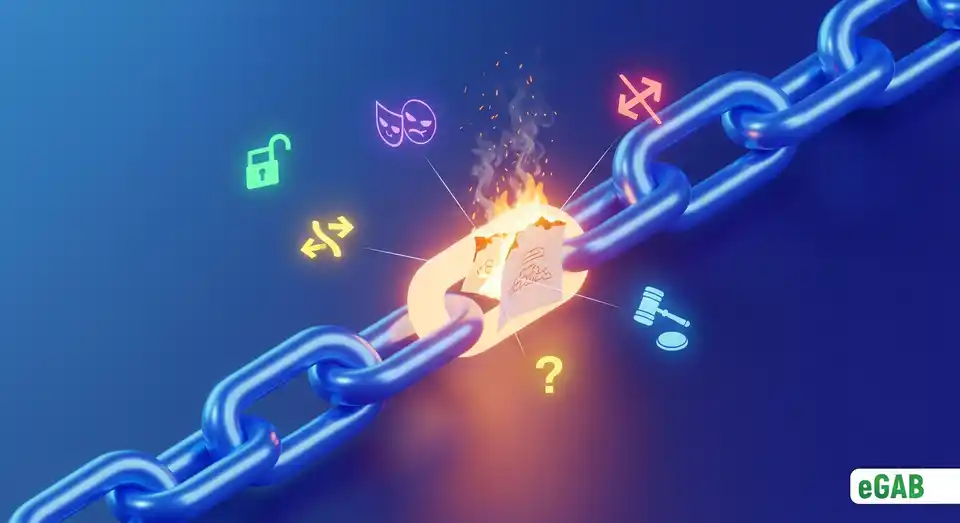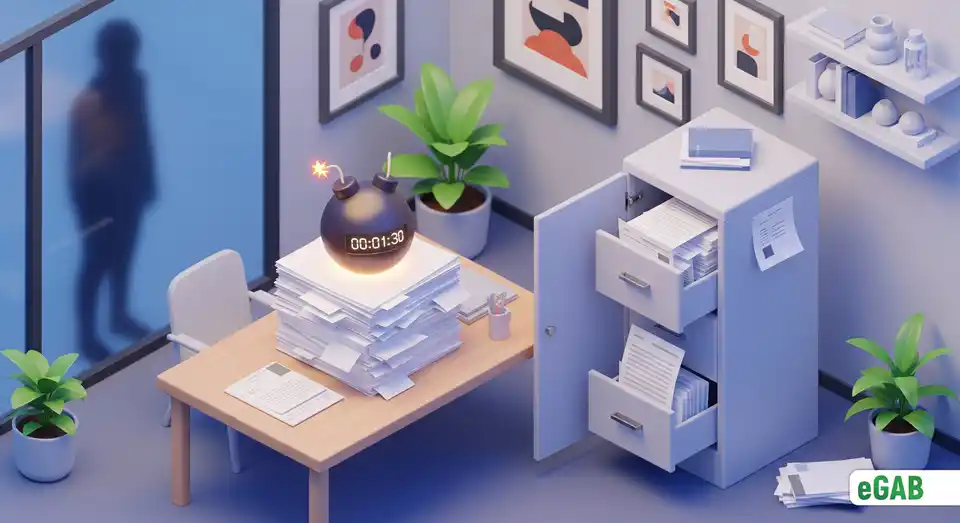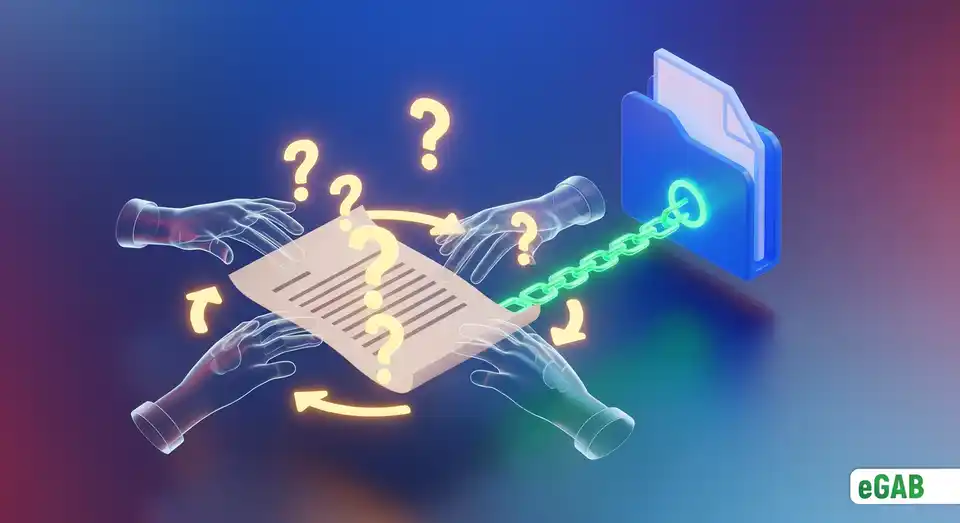Beyond the Shredder: 5 Critical Data Security Risks of Paper Documents

 Author:
Artem Grigoriev
Author:
Artem Grigoriev
- Why is Uncontrolled Physical Access a Ticking Time Bomb?
- How Do Paper Documents Fuel Industrial Espionage?
- What Are the Hidden Dangers of Accidental Data Exposure?
- Why is the Paper Lifecycle Impossible to Audit?
- How Do Paper Breaches Lead to Serious Compliance Penalties?
- How eGAB Neutralizes the Data Security Risks of Paper
- Summary: The Tangible Dangers of Paper in a Digital World
We're all focused on firewalls and advanced encryption. But when did you last worry about that printed report on your desk? We've become so focused on digital threats that it's easy to forget a simple truth: paper is a huge and dangerous security blind spot . These physical documents pose a critical risk that we often underestimate. A single mistake can cause a major problem. Think about leaving a sensitive file in a meeting room or a deliberate act of industrial espionage. The scary part? These things happen without triggering a single digital alert. The danger goes far beyond just a misplaced page. We're talking about the very real possibility of a paper data breach , which can come from uncontrolled physical access or even simple human error. This article goes beyond the obvious "shred your documents" advice. Instead, we'll dive deep into the five critical data security risks of paper. You'll see exactly how they lead to everything from devastating information leaks to serious compliance failures.
📘 This post is part of our comprehensive guide to "The Problems with Paper Documents: A Complete Guide". Explore it to find answers to all your questions ;)
Why is Uncontrolled Physical Access a Ticking Time Bomb?
Take a quick look around your office. See that sensitive report on a colleague's desk? That unlocked filing cabinet in the corner? We’ve all seen it, but these seemingly harmless moments are a huge security risk. In fact, one of the biggest threats to any organization is uncontrolled physical access -when there’s nothing to stop someone from just walking up and taking a confidential document. This lack of physical document security creates a whole category of risks that modern digital systems were built to prevent. When you leave unsecured documents lying around in common areas like printer trays or meeting rooms, you're essentially rolling out the welcome mat for trouble. Anyone-from unauthorized employees to the cleaning crew or a casual visitor-can easily view, copy, or walk away with your company's most valuable secrets. This completely undermines the most basic rule of data protection: you must keep sensitive information secure.
And if you think this rarely happens, the official data tells a much different story. Year after year, reports from the UK's Information Commissioner's Office (ICO) make it clear that a huge number of security incidents start with these simple physical mistakes. So, what is a physical security compromise? It's any event where physical barriers fail, allowing someone unauthorized to access sensitive information-like a confidential document being swiped from a desk. The risk gets even bigger when you factor in insider threats , which are risks posed by your current or former employees. These insider threats to paper documents are especially dangerous because the person already has legitimate access to the building. A disgruntled employee doesn't need to be a master hacker to cause serious damage; all they have to do is discreetly pocket a client list, a financial report, or a strategic plan. And the worst part? With paper, there's no digital trail and no instant alert flagging the theft. Your secure digital systems require passwords and authentication-a vital form of access control that's completely missing with paper. Too often, the only thing protecting a paper document is a flimsy lock or just being out of sight. This is exactly why a strict clean desk policy , requiring employees to clear their desks of all sensitive documents at the end of the day, is so absolutely essential. This unfortunate reality leaves your most critical corporate information incredibly vulnerable to both careless mistakes and malicious attacks.
Takeaway: Remember, your information security is only as strong as its weakest link. A forgotten document on a printer is just as exposed as an unencrypted server. It's time to treat your physical documents with the same secure mindset and strict access controls that you already use for your digital files.

How Do Paper Documents Fuel Industrial Espionage?
In the cutthroat world of modern business, information is everything. That’s why, for corporate spies, paper documents are a goldmine for industrial espionage -the theft of your trade secrets. In fact, the industrial espionage physical documents enable is often far harder to trace than a digital breach. Just think about it: a spy can photograph or copy physical records holding your valuable trade secrets, sensitive R&D data, or proprietary formulas (the confidential recipes that give your company its competitive edge) in just a few seconds. And the scariest part? That simple act leaves behind zero digital footprints, meaning you might never know a breach even happened. This isn't a scene from a spy movie; it's a real threat to your company's survival.
Let's take Germany, a major hub of the European economy, as an example. A revealing 2023 study from the digital association Bitkom showed just how serious this is . The study found that 7% of the companies surveyed had experienced the theft of sensitive physical documents, files, or even entire prototypes. Imagine what a competitor could do with that kind of proprietary information. What if they got ahold of your strategic plans, key customer contracts, or confidential price lists? The damage from such a leak could be catastrophic. That same study revealed something staggering: a full 75% of all companies surveyed in Germany had been hit by some form of espionage, sabotage, or data theft. Even the documents you throw away are a prime target. If you aren't disposing of them immediately and securely, you're leaving them extremely vulnerable. So, how can you prevent industrial espionage through physical documents? Using a proper security measure like a cross-cut shredder is essential. Otherwise, someone can easily snatch your sensitive documents from unsecured bins-a classic tactic known as "dumpster diving."
Why It Matters: Make no mistake: Industrial espionage isn't about someone stealing office supplies. It’s about them stealing your company's entire future. A single stolen document can wipe out years of hard work, destroy your competitive advantage, and hand a decisive win to your biggest competitor.

What Are the Hidden Dangers of Accidental Data Exposure?
While a corporate spy makes for a good story, the truth about data breaches is usually much simpler. The most common cause of a paper-based data breach is, in fact, simple human error-and unfortunately, the consequences are just as severe. This kind of accidental data exposure is the root of the most common type of paper data breach . When you look at security incident reports from official regulatory bodies (government agencies that enforce laws), the data is crystal clear: physical breaches are almost always caused by these unintentional mistakes.
For instance, official data from the UK's Information Commissioner’s Office (ICO) on security incident trends tells a consistent and alarming story. Year after year, the ICO names "data posted or faxed to the incorrect recipient" and "loss or theft of paperwork" as top issues. These are consistently two of the most reported non-cyber incidents (security breaches that don't involve computers or networks).
So,
how do paper documents cause data breaches?
It can be as simple as someone putting a sensitive document in the wrong folder on a busy afternoon, or leaving a file on a train or in a coffee shop. Other times, an envelope gets sent to the wrong person through the internal mail system. The ICO’s own data confirms that this specific mistake-sending mail to the wrong address-is a leading cause of data breaches. This risk skyrockets when employees take documents home to work. Suddenly, your sensitive corporate data is sitting in an uncontrolled environment where your company’s security policies are nearly impossible to enforce. This reality points to a huge gap in
confidential document security
, a key reason why a paper-based office fails its remote team. In fact, a survey from a shredding service revealed something startling:
25%
of employees working from home admit they don't always follow secure data destruction policies. This critical oversight leaves critical information vulnerable in home offices and personal recycling bins everywhere.
Quick Insight: Remember, a disaster doesn't need a villain; a simple mistake can expose your most sensitive data. Think of a misplaced file or a document mailed to the wrong address-it's just as damaging as a targeted cyberattack. Your best defense is to strengthen your internal processes, train your team thoroughly, and create clear, easy-to-follow rules for handling all physical documents.

Why is the Paper Lifecycle Impossible to Audit?
Imagine trying to solve a crime with no witnesses, fingerprints, or security footage. That’s exactly what it’s like investigating a data breach involving paper documents. By its very nature, paper gives you no digital audit trail (an electronic record of who accessed information and when) or chain of custody (a chronological paper trail showing its control and transfer). You can't know for sure who has accessed a document, or who might have copied, modified, or moved it. The entire document lifecycle , from creation to secure disposal, is always a question mark, which makes creating a disaster-proof document strategy so challenging.
This total lack of oversight is a massive
information governance failure
(a breakdown in the rules for how information should be handled). What happens if you discover a breach weeks or months later? It's nearly impossible to figure out the full scope of the damage. This is exactly
why it is difficult to audit paper document access
-there's simply no data log to check. You can't know who was behind it. Was it an insider or an outsider? How many other documents were also taken? With paper, you'll probably never get clear answers to these critical questions. The entire journey of a paper document is a manual process that's wide open to human error, representing the ultimate bottleneck for business automation. In fact, the Verizon 2024 Data Breach Investigations Report (DBIR) found this was a factor in
33%
of all breaches involving a physical component. Now, think about digital files. Every access, edit, and transfer is logged and can be monitored. But the hands-on nature of paper gives you no built-in checks and balances. This huge vulnerability is why breaches from simple loss or theft are still such a major and persistent threat.
Next Step: Try this quick exercise: compare the lifecycle of a sensitive paper document in your office to that of a secure digital file. The digital file has a clear, unchangeable log of every single touchpoint. The paper document? Its history is a complete mystery. This simple thought experiment clearly shows the unavoidable risk you take every time you rely on paper.

How Do Paper Breaches Lead to Serious Compliance Penalties?
A security breach with paper documents isn't just an internal headache. It's a major
compliance failure
(a violation of legal or regulatory rules) that can trigger huge financial penalties and serious legal trouble. Strict data protection laws like the
General Data Protection Regulation (
GDPR
)
in Europe and the
Health Insurance Portability and Accountability Act (
HIPAA
)
in the U.S. have clear rules for protecting personal information. For instance, strong
HIPAA physical document security
is mandatory for protecting sensitive patient health information. And let's be crystal clear: those rules apply just as much to a piece of paper as they do to a digital file. That makes
GDPR compliance for paper records
a non-negotiable, turning archives into a potential legal time bomb under data retention laws.
Failing to properly secure, store, or destroy these physical documents is a direct violation of the law. It goes against core security principles like GDPR's Article 32 (
"Security of processing,"
which requires organizations to implement security measures), and you can be sure regulators don't take these failures lightly. So,
are paper documents a compliance risk under GDPR?
Absolutely, and the massive penalties prove it. Under
GDPR
, a breach with paper records can lead to fines of up to
€20 million
or
4%
of your company’s total global annual revenue-whichever is higher. But
what are the penalties for a paper data breach
beyond that initial fine? The costs just keep adding up, revealing the true cost of paper-based workflows. And the financial pain is only getting worse. The
IBM Cost of a Data Breach Report 2024
found that the global average cost of a data breach has hit a staggering
$4.50 million
. That same report highlights a critical point: breaches from a
physical security compromise
(a failure in physical safeguards) took an average of 299 days just to identify and contain. Beyond the fines, a paper data breach can permanently damage your organization by destroying your reputation, eroding customer trust, and leading to expensive class-action lawsuits.
Did You Know? The cost of a data breach goes way beyond the regulatory fine. It also includes the high costs of investigating the incident, notifying everyone affected, and even providing credit monitoring for victims. On top of all that, you have the long-term loss of business from a damaged reputation. Securing your paper documents isn't just an expense; it's a critical investment in your company's survival.

How eGAB Neutralizes the Data Security Risks of Paper
In a digital world, paper is a security liability . It's vulnerable to unauthorized copying, alteration , theft, and accidental exposure. A simple shredder can't protect you from the most significant data security risks. eGAB neutralizes these threats by replacing the inherent insecurity of paper with the mathematical certainty of cryptographic security .
First, the blockchain’s immutability protects your documents, making unauthorized alteration or destruction impossible. But eGAB also solves the "insider threat." It creates a transparent, auditable trail of every interaction with a document's verification record. Access is controlled by digital permissions, not physical proximity, meaning you no longer have to worry about unauthorized viewing by colleagues or visitors.
Most importantly, eGAB protects against fraudulent use . Shredding a document only destroys one copy; it does nothing to stop a fraudulent copy from circulating. Because eGAB documents are digitally verifiable , you can challenge and confirm-or prove false-the authenticity of any credential instantly. This ensures that even if a document's content is somehow exposed, its legitimacy can never be successfully faked.
Next Step: Think about your current "clean desk" policy. How effective is it, really? Paper documents left unattended are your biggest vulnerability. eGAB removes that risk by ensuring the authoritative version of any document is always digital, secure, and accessible only to the right people.

Summary: The Tangible Dangers of Paper in a Digital World
Modern security has a clear blind spot. In our focus on digital threats, we've let physical paper documents become a critical risk. From creation to disposal, a paper document's lifecycle is full of dangers just as costly as any cyberattack. It all starts with one core problem: uncontrolled physical access . Think of a sensitive report on a desk or a file in an unlocked cabinet. It's an open invitation for internal insider threats and a welcome mat for external theft.
This single failure point fuels two equally dangerous outcomes. On one hand, it paves the way for simple human error, leading to the most common type of accidental data exposure . A classic example is mailing confidential data to the wrong person-something regulators like the UK’s ICO consistently rank as a top cause of breaches. On the other hand, for someone with bad intentions, it’s a goldmine for industrial espionage . Competitors can easily photograph or steal your plans, and the worst part is, they leave behind zero digital evidence.
But the danger doesn't stop there. When a paper breach happens, the investigation is instantly crippled. Why? Because paper offers no digital audit trail (a secure record of who accessed what, and when). It also lacks a verifiable chain of custody (a log of who had the document).
This critical information governance failure has serious consequences. It makes it nearly impossible to know who accessed the document, when the breach happened, or how widespread the damage is. This isn't just a theory-Verizon found this issue is a factor in a third of all physical breaches. This total lack of control leads to the final, most devastating consequence: serious compliance penalties .
Here’s the bottom line: Strict data protection laws like
GDPR
and
HIPAA
don't distinguish between digital and physical files. A file on a server is treated the same as one in a cabinet. That means a failure in
physical document security
is a direct compliance violation, exposing your organization to staggering fines-up to
€20 million
under GDPR. It also contributes to the average breach cost of $4.50 million, according to IBM. The journey of an unsecured paper document is a dangerous one that starts at an unguarded desk and can end in a courtroom. It's a chain of severe, tangible, and financially devastating risks that no modern organization can afford to ignore.
➡️ Where do you go from here? Now that you're aware of the data security risks, let's pinpoint the physical weak link. Uncover the hidden risks lurking in your filing cabinet.

The Environmental Footprint of a Single Paper Document: A 2025 Report
A Practical Guide to Organizing Your Paper Document Archive
Are Your Paper Archives a Legal Time Bomb? Understanding GDPR and Data Retention
The Ultimate Bottleneck: How Paper-Based Processes Are Killing Your Business Automation
What Are Verifiable Documents? A Beginner's Guide to the Future of Trust
